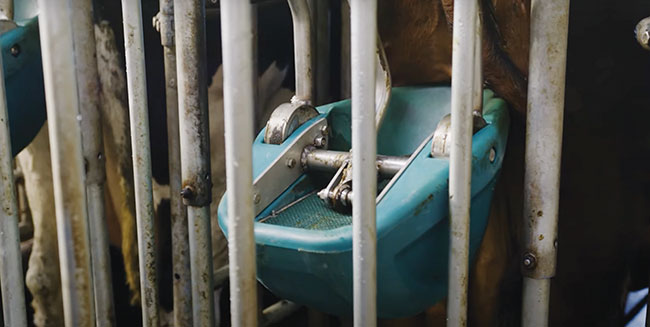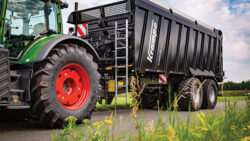
Features
Air quality
Equipment
Regulations
Tractors
Return to Eurotier Manure equipment highlights
In a special edition of our U.K. Update, we hit the ground at the first in-person EuroTier Show since 2019 to evaluate the latest in manure technology.
April 5, 2023 by CHRIS McCULLOUGH
 The Hanskamp CowToilet collects urine directly from cows, separating it from feces.
Image courtesy of Hanskamp
The Hanskamp CowToilet collects urine directly from cows, separating it from feces.
Image courtesy of Hanskamp Visitors to the 2023 EuroTier Show in Germany were able to view for themselves the latest equipment and technology available to handle manure and slurry (liquid manure).
Initially held every two years but cancelled in 2020 due to the COVID-19 pandemic, EuroTier is widely recognized as the world’s leading trade fair for livestock husbandry.
Around 106,000 visitors from 141 countries attended the event in Hannover, checking out the latest innovations exhibited by 1,800 companies from 57 countries.
Slurry and manure equipment came in all different sizes, colors and prices, but the general theme throughout the conference was that there is a big move to reduce the emissions from livestock farms produced by waste.
With numerous dribble bar options on many of the stands, farmers were left in no doubt that this type of spreading is the future.
Tankers, too, came in all shapes and sizes with single, tandem and triple axles competing to see which was best at staying above ground.
As always, there was a sold connection between slurry (or “muck”) machinery and the equipment used to separate, and those used to produce energy.
There was even a machine to sieve manure from bedding – and let’s not forget the growing numner of little robots buzzing around the sheds cleaning up after the cows. A dedicated “robot zone” at the show highlighted how easy these little robotic scrapers can keep a cow barn clean with a number of manufacturers taking part.
With a lack of labor availability becoming a huge problem on livestock farms around the world, using robots is an alternative. But, of course, the cost of such a system will not fit into every farm’s operating budget.
Fliegl Tapir 375
Separating slurry is becoming very popular as farmers begin to realize the benefits. Fliegl’s Tapir 375 combines all the advantages of a mobile separator with those of a large press screw principle. An enlarged sieve with a diameter of 300mm and a length of 750mm enables the intake of up to 35 cubic metres per hour of cattle slurry. The optimised auger inside presses the liquid manure mixture even more strongly against the surrounding sieve and thus achieves an even better pressing result. As a result, the Tapir 375 separates 40 percent more efficiently than conventional standard separators.
Hanskamp CowToilet
Every cubicle house needs a toilet, so Dutch company Hanskamp came up with one for cows. The CowToilet collect urine directly from the source separately from feces, to ensure both nutrients can be optimally used separately. As the urine does not come into contact with the feces, considerably less ammonia is formed. This deals with an ammonia surplus at the source and makes the CowToilet a solution to reduce emissions. The CowToilet uses a natural nerve reflex that causes the cow to urinate. This technique has been automated by Hanskamp and integrated into a specially designed CowToilet cubicle that can be placed in any dairy shed. The urine is collected in the reservoir of the CowToilet and is then pumped out and stored separately.
New Holland T6 methane tractor
Using liquid manure to power a tractor is one of the latest crazes to help reduce dependence on emission-emitting diesel, but the theory has a long way to go. On display was New Holland’s T6 Methane Power, the world’s first 100 percent methane-powered production tractor. Its design has now been enhanced with a six-cylinder, 145hp rated/175hp boosted natural gas engine, which is coupled to the proven Electro Command four-speed semi-powershift transmission. With the same levels of power and torque as its diesel equivalent, owners benefit from up to 30 percent lower running costs. Producing 98 percent less particulate matter, reducing CO2 emissions by 11 percent and overall emissions by 80 percent when using biomethane near-zero CO2 emissions are achievable.
Moscha lightweight boom
Moscha exhibited its award-winning lightweight slurry boom, which has a plastic pipe as a supporting construction element. Moscha achieves this by using covered plastic pipes instead of metal, which significantly reduces the weight of the folding boom. The precise spreading of liquid manure close to the ground with a drag hose or drag shoe attached to corresponding boom technology can also be used on lighter trailers requiring less tractive power and on more extensively contoured terrain.
Royal de Boer Auto Scraper Spray
One of the many shed scraping robots in action at EuroTier was the Auto Scraper Spray model from Royal de Boer. This unit is fully programmable in terms of cleaning routes, frequency of cleaning and a progress report. The robotic scraper comes in three versions. The most straightforward one, and also the base unit, is the Auto-Scraper. The Auto-Scraper Pro is more intelligent, and the Auto-Scraper Spray is equipped with a water spray system. The machine follows the sides of the barn and stops when it reaches its charging station. In places where no side guides are available, beams with a height of 8cms should be placed. The scraper robot will initiate its next lap when the next pre-programmed start time begins. The Auto-Scraper robot is available in operating widths of 140, 170 and 200cms.
Joskin Terraflex/2 XXL

Joskin’s Terraflex/2 XXL arable injector allows a better loosening of ground.
Joskin’s Terraflex/2 XXL arable injector is made of a galvanised double-beam frame with two rows of Everstrong spring tines with 6.5 centimeters wide shares at their ends. The shape of the tines allows a better loosening of the ground thanks to their vibrating effect, a good mixing of the vegetable residue and a perfect tearing of the plough soil for a better preparation of the seed bed. The wide opening of the shares ensures a very good flow of the slurry and a wide distribution. The distance between the tines is 30cm or 37.5cm, depending on the model, and the distance between the two rows is 70cm. Slurry is usually injected on a 12 to 15cm working depth.
Krampe RamBody 750

The Krampe RamBody 750 features five hydraulic rams to provide powerful feed force.
Image courtesy of Krampe
Krampe exhibited its huge RamBody 750 push-off trailer used to transport farmyard manure, poultry manure or crops. This trailer has a strongly built body with a load volume of 41.1 cubic metres. Besides the standard parabolic springs or a running gear with hydraulic axle compensation, Krampe recommends the pneumatic running gear. As a unique selling point, BPW steering axles with overhead brake cylinders are being mounted which guarantee a high ground clearance. The core of this trailer is the push-blade mounted on a following-on table. The narrow designed tunnel in the centre protects the hydraulic rams from damage. A total of five hydraulic rams provide the powerful feed force and offer large reserves also in order to safely empty an overloaded vehicle.
Fliegl Snake 150
With a working width of 15m, the Fliegl Snake 150 can be used to spread slurry directly connected behind the tractor or attached to self-propelled liquid manure spreaders. This particular model weighs in at 2.55 tonnes, has 60 operational spouts and measures 2.6m wide by 3.8m tall. With the help of the digital flow meter Fliegl Flow Control, a homogeneous spreading result can be achieved on the ground. It is equipped with the Fliegl screw distributor and has a drip stop bonus at the headland thanks to hydraulic folding.
Hanskamp AgroTech BeddingCleaner
Pulled by a tractor, the BeddingCleaner cleans the bedding from cow barns when required. The bedding material is sieved using a sieve mat. After this the bedding that is not contaminated drops back into the stable. Conversely, a small amount of the bedding material sticks to the settled faeces, with the result that it can be easily collected by the mounting and transported into the integrated storage bunker. Bedding material subsequently remains cleaner and drier, and can be used for longer periods. •